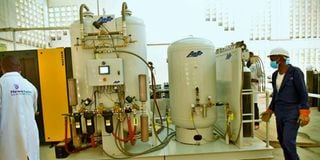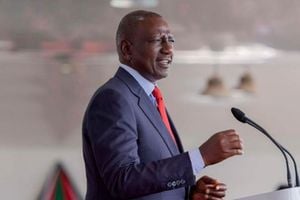90pc of emergency facilities in Kenya lack piped oxygen

An oxygen production machine at Nakuru Level Five Hospital.
A report by Access to Medicine Foundation says over 30 per cent of emergency care centres in the country have no regular supply of oxygen.
Last year, the Ministry of Health (MoH) disclosed that oxygen availability in public hospitals was low at 16 per cent. Given that medical oxygen is included in the World Health Organization’s model list of essential medicines, the new report shows the issue is urgent and on a vast scale.
In 2020, a report published by the MoH recommended the need to scale up medical oxygen availability in public primary hospitals as availability was higher in private facilities and secondary hospitals.
“In a recent survey of emergency care centres across Kenya, over 30 per cent of the facilities did not have a regular supply of oxygen. Close to 90 per cent of those with oxygen did not have piped oxygen in the emergency department and delivered oxygen directly from the tanks to the patient.
“Pipeline intra-hospital oxygen distribution networks are helpful to supply oxygen at high pressure to equipment such as anaesthetic machines and ventilators or directly connected to patients with a flow-meter and tubing,” Access to Medicine Foundation said.
It added that a key advantage of pipeline systems is that they allow the distribution of oxygen to multiple patients simultaneously and obviate the need for handling and transporting heavy cylinders between hospital wards.
The findings come two days after President William Ruto flagged off 20,620 medical oxygen cylinders to 47 counties.
“We are here to witness the crowning moment of a highly successful partnership that has seen us through the hardest of times and strengthened us for the future. As we flag off 20,620 medical oxygen cylinders for delivery to the 47 counties, let us reflect deeply upon, but also appreciate with gratitude and celebrate an exemplary partnership that has remained committed and transformative.
“A major vulnerability highlighted by the Covid-19 pandemic is the medical oxygen supply chain. Kenya has sub-optimal oxygen supply and poor infrastructure as a result of which it is minimally available in public health facilities,” President Ruto said.
He reminded Kenyans that Covid-19 drastically intensified demand for oxygen, raising its cost by more than 75 per cent and as a result, suffering Kenyans and their distressed families were driven into unprecedented desperation.
“The Global Fund has been immensely supportive of our efforts to strengthen our national medical oxygen ecosystem and I appreciate the Fund’s 41.7 million dollars investment through Amref Medical to support our oxygen supply and comprehensive infrastructure improvement. This covers refill of compressed and cryogenic oxygen, acquisition of tanks and cylinders, installation of high volume PSA oxygen generation plants and the piping and installation of manifolds as well as oxygen outlets to health facilities.
“The most important is, of course, the fact that every intervention in the provision of healthcare is of fundamental importance to the government. Our commitment goes beyond the traditional delivery of health services as a public good. The provision of universal healthcare comes out of the recognition of the singular opportunity to intervene radically and make healthcare inclusive, accessible, affordable and of high quality.”
Access hurdles
The foundation agrees that Covid crippled supply of medical oxygen. “Spurred by the Covid-19 pandemic, some of the world’s leading producers of medical liquid oxygen took steps – or pursued ad hoc initiatives – to expand access to their lifesaving product in some of the low- and middle-income countries (LMICs) experiencing critical oxygen shortages during the global health crisis. However, the underlying, longstanding problem of a persistent lack of access to medical oxygen in LMICs remains largely unaddressed.”
It is, however, of the view that the underlying, longstanding problem of a persistent lack of access to medical oxygen in LMICs remains largely unaddressed. This is why the report analyses what gas companies have done so far to tackle this inequity and identifies tangible actions they can take to expand access to medical liquid oxygen over the long term.
“Many medical facilities in LMICs do not have reliable access to medical oxygen, which is a lifesaving treatment for an array of diseases, such as pneumonia and tuberculosis. It is also essential for daily medical procedures, for example during surgery and childbirth.”
This report looks at access efforts from six of the world’s largest global gas companies that also produce medical liquid oxygen: Air Liquide, Air Products, Linde, Messer, Nippon Sanso Holdings Corporation and SOL Group, “the official document notes.
Jayasree K Iyer, CEO, Access to Medicine Foundation believes that these companies must make paying their part a priority.
“With a small number of companies responsible for the world’s supply of medical liquid oxygen, the role they play in the global health ecosystem needs to be prioritised. Medical gases are a small part of these companies’ business, yet society needs them to ensure this vital lifeline is available both during emergencies and to meet the daily medical oxygen needs of all health systems,” the CEO said.





